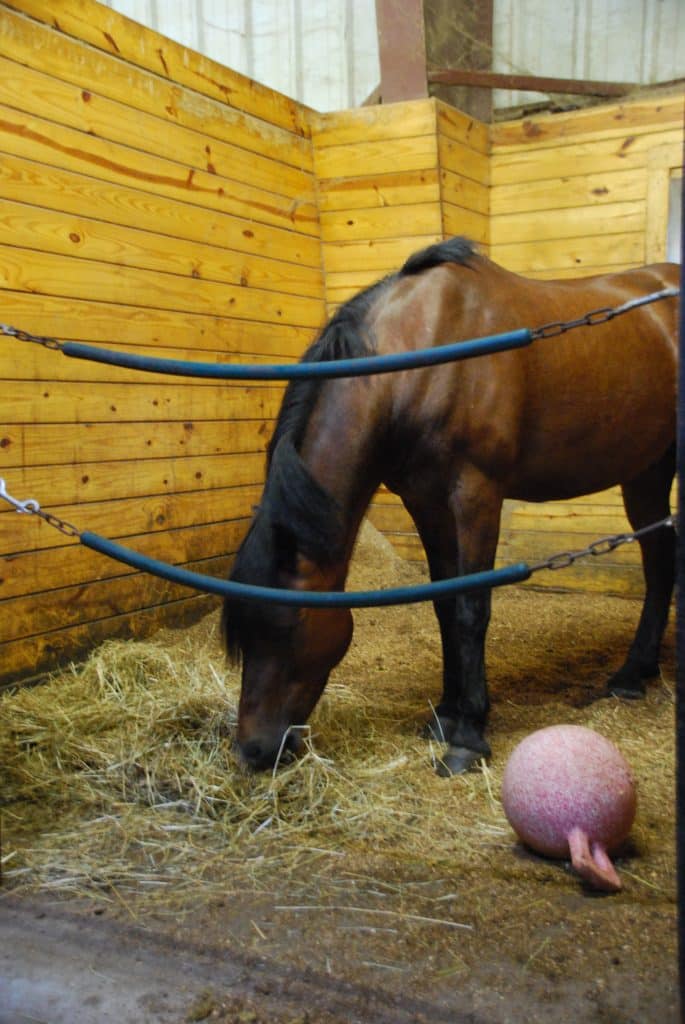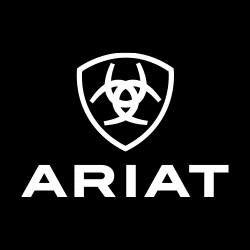
When turnout isn’t possible, creative enrichment can help an OTTB stay engaged, ease frustration, and reduce the risk of unwanted behaviors.
Photo by Alexandra Beckstett
Lack of turnout or exercise—due to injury, weather or barn management limitations—can quickly leave off-track Thoroughbreds (OTTBs) bored, stressed or frustrated.
Extended stall time can take a toll on both their mental and physical health, sometimes leading to the development or worsening of behaviors such as pawing, weaving or stall walking. But with a bit of creativity, you can find plenty of enrichment approaches that can help your OTTB stay mentally engaged and more comfortable while confined.
In this guide equine behavior experts share practical ideas you can try at home to support your horse’s well-being during stall rest or periods of limited turnout.
Stall-Related Behavior Challenges in OTTBs
Horses often develop behavioral challenges out of frustration—referred to by behaviorists as stereotypies but commonly known as vices—when they experience boredom, stress or a lack of mental stimulation during extended stall confinement. However, signs of frustration can sometimes be subtle.
“Some horses are predisposed to certain stereotypies and, in stressful situations like stall rest, those behaviors may become more frequent or intense,” says Sue McDonnell, MS, PhD, CAAB, HMACT, adjunct professor of reproduction and behavior, and founding head of the equine behavior program at the University of Pennsylvania School of Veterinary Medicine’s New Bolton Center, in Kennett Square. “But in my experience, most horses don’t develop entirely new problem behaviors during that time. You might see increased certain activities—such as stall walking or calling out—but it’s not always vices like weaving or pacing unless they’ve been inside for a long stretch. In a few rare cases I’ve seen stereotypic behaviors emerge during extended layups, but that’s the exception, not the rule. A lot of these behaviors center around logical triggers like seeing other horses turned out while they’re stuck inside.”
“I think frustration is a fair way to describe what we start to see when horses have limited turnout or restricted exercise, like during injury recovery,” says Amy McLean, PhD, assistant professor at the University of California, Davis. “That’s when you may notice an increase in locomotor activity—repetitive movement as a way of coping.”
This type of locomotor activity often starts with mild pacing near the window or door. But if left unaddressed, it can stimulate the horse’s cortisol response and develop into a neurologically soothing habit—much like how dogs might self-soothe by licking their paws.
“Some horses will start with coping behaviors such as weaving, circling, pawing or even kicking the stall wall,” McLean says. “Others may develop more complex behaviors like cribbing. However, it’s important to watch for even subtle changes. If they’re moving more in the stall or lying down less, that’s a cue to start incorporating enrichment tools.”
In some cases horses cycle between bursts of activity and what looks like depression. Over time, especially during extended stall confinement, some horses might slip into those patterns for days at a time.
“Interestingly, Thoroughbreds tend to be slower to reach that point compared to other breeds,” says McDonnell. “Standardbreds and some Quarter Horse lines, for example, often seem quicker to give in, and that may relate to their training history or how they’ve been managed. It’s important to recognize these mental shifts early to give the horse something else to focus on. If they’re stuck on stall rest and turnout isn’t an option, enrichment tools can help redirect that mental energy before it turns into a full-blown vice.”
Enrichment Activities for Stall-Bound OTTBs
When turnout isn’t possible, creative enrichment can help an OTTB stay engaged, ease frustration, and reduce the risk of unwanted behaviors.
Always keep in mind that each horse has its unique preferences. In addition, consider reintroducing a variety of enrichment activities throughout the day, especially during downtime between feedings or hand-walking sessions, to help keep the horse mentally engaged and prevent boredom.
“Find out what kind of enrichment that horse will enjoy—ideally before they’re on stall rest,” says McLean. “Some horses respond well to forage balls, Jolly Balls, treat toys, music or even mirrors, but their preferences can vary. It also helps to rotate enrichment tools regularly. If the same item is always there, they may lose interest and fall back into stall walking, pawing or other coping behaviors.”
“There’s actually a lot that can be done to help these horses, and I’m often surprised by how little is implemented,” adds McDonell.
The Outdoor Stall
Fortunately, horses on stall rest can safely get a change of scenery without compromising their recovery. McDonell says horses often take fewer steps and place less strain on their injuries in a small outdoor stall than they do pacing inside. These enclosures can be set up in or beside the pasture to help the horse stay socially connected to the herd—providing interaction and routine without the risks that come with full turnout.
“One of the most helpful things, in my experience, is giving the horse a change of scenery,” says McDonnell. Even if they can’t go out in a paddock or be with other horses, you can move them to a different stall or create a small outdoor stall using round pen panels. Just four 10-foot panels make a 10-by-10 space—small enough to restrict movement but open enough for the horse to stay visually connected to their environment.”
Foraging Enrichment Activities
Horses need forage for both digestive and mental health. Forage-based enrichment, such as hay nets with small holes or slow feeders, can extend forage intake, though they keep the horse in one spot.
“A simple way to encourage movement is by scattering small flakes of hay around the stall or paddock,” McLean says. “I do this by tearing flakes into smaller portions and placing them in different areas. It mimics natural grazing, keeps them moving and helps reduce boredom. For picky eaters, it also encourages more consistent forage intake.”
“One of the best ways to support natural behavior is to encourage the horse to move every few bites and eat with their head down—just like grazing,” says McDonnell. “This mimics their natural rhythm of taking a few bites, then moving a few steps, which helps regulate both digestion and mental well-being. Designing a stall so they can see their surroundings while their head is down also helps reduce anxiety, especially when they’re alone in the barn.”
A simple way to encourage “stall grazing” is by placing small flakes of hay at the 12, 3, 6 and 9 o’clock positions around the stall. “This setup encourages movement and mimics pasture behavior,” adds McDonnell. “Some people also use Hay Pillows—durable pouches that hold a flake of hay—so horses have to paw or work to get the hay out. That kind of purposeful behavior is a key part of effective enrichment.”
Forage balls can provide effective enrichment between feedings and, in some cases, even function as the primary feeding method if the contents meet the horse’s nutritional needs. “Forage balls encourage movement, allowing the horse to walk and nibble without overexerting, which can be both physically and mentally stimulating during stall rest,” says McLean.
Keeping horses as ulcer-free as possible during stall rest can also make a big difference. “When they’re confined, that digestive discomfort becomes harder to ignore—there’s nothing to distract them from the constant belly ache,” adds McDonnell. Free access to good quality hay can help prevent gastric ulcers. There are many gastric supplements available, but talk to your veterinarian or equine nutritionist about which ones might help.
Playing Music
Many barns have music playing but be sure to consider how the type of music influences a horse’s mental state.
“Music can be soothing for horses—it all depends on the type,” says McLean. “If you play something upbeat with a fast tempo, you might see horses become more excited or even agitated. But calming music, like lullabies or nature sounds—birds singing, flowing water—has been shown to help horses relax. In some studies, horses exposed to these sounds spent more time lying down and even engaged in social behaviors like mutual grooming when near a stall mate.”
Homemade Licks
One creative enrichment idea—especially in summer—involves making homemade ice licks.
“I use a bundt pan to freeze water with bits of carrot, apple or alfalfa, then hang it from a string through the center,” explains McDonnell. “Most horses get really focused on it and will lick for hours, which is a healthy outlet compared to gnawing on stall walls or bars out of frustration. You can even use electrolyte water on hot days for added benefit. It’s inexpensive, easy to prep in batches and can keep them engaged for two to three hours.”
Cognitive Exercises and Stretches
While a horse might have exercise limitations, you can still introduce low-impact exercises in a stall, barn aisle or in-hand in an arena.
“If you can incorporate simple cognitive exercises—like 10 minutes of daily target training—it can make a big difference, especially for stall-bound horses,” says McDonnell. “You can even train them to perform their own physical therapy movements, such as carrot stretches, which are becoming more common as rehab plans. It can be easy to teach horses to do their own therapy exercises using target training and eventually even respond to cues without a target. It’s rewarding for both the horse and the handler.”
Mirrors, Posters and Other Visual Companionship Items
Visual enrichment can offer mental stimulation and reduce feelings of isolation for a stalled horse, especially when having a companion in the barn isn’t an option.
“Mirrors have long been used as enrichment, particularly in hospital stalls,” says McDonnell. “Some horses will stand quietly beside them, almost like they’re socializing. But they’re not for everyone—stallions and some geldings may view the reflection as a threat and become aggressive, so it depends on the individual.”
“Hanging a mirror can be an enrichment option, but in our study, it was the least effective method,” says McLean. “Some horses became frustrated or confused—one even tried to tear it off the wall. Like any tool, it works for some horses but not all.”
Another creative form of enrichment involves using virtual or picture companionship. “I have a poster that shows three horses lying on a hillside with one standing as a sentinel—sending a visual signal of safety and calm,” says McDonnell. “You wouldn’t think a poster could have that effect but, when positioned across the aisle or on an adjacent stall wall, horses often seem to interpret it as the presence of others. I’ve also used videos, and they can be effective even on a small screen.”
Take-Home Message
When you must confine your OTTB to a stall, enrichment becomes essential for supporting his or her mental and physical well-being.
Horses’ reactions differ, so try a variety of options, rotate them regularly and pay attention to what works best for your horse. A bit of creativity can make a big difference in easing frustration and keeping your OTTB healthy and content during extended stall time.

